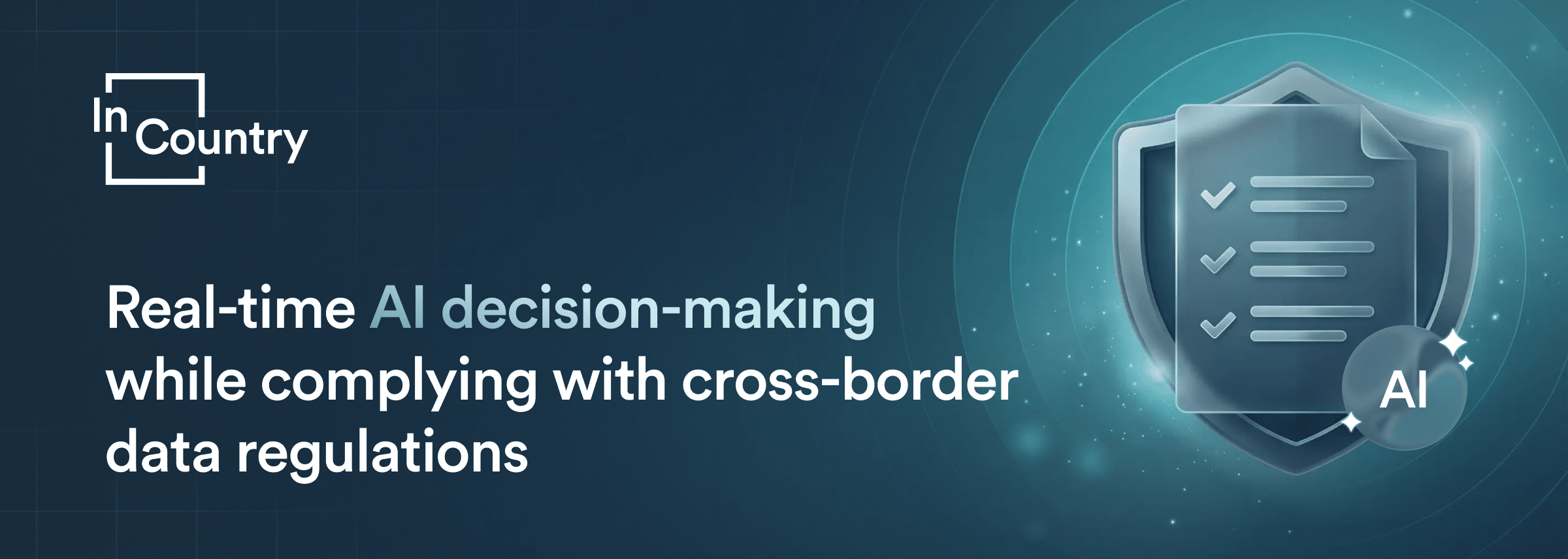Enterprises want to harness the power of artificial intelligence (AI) in real time, making split-second decisions, automating operational flows, personalising customer experiences, optimizing logistics and risk management. Yet doing so across borders raises a critical question: where is the data being processed, stored or transferred, and does that comply with local and international regulations?
In this blog we will explore how organisations can deploy real-time AI decision-making systems while also respecting the evolving landscape of cross-border data regulation: from data residency and localisation rules to aggregate AI-governance frameworks. We’ll look at the business opportunities, regulatory constraints, technical architectures, and key best practices that enable compliant, agile, real-time AI.
Why real-time AI decision-making matters
Real-time AI decision-making means that an AI system ingests data (often streaming or near-streaming), processes it, analyses it, and delivers outputs (decisions, alerts, automated actions) with very little delay. Examples include:
- A fraud-detection engine in a global bank that flags suspicious transactions in milliseconds.
- A logistics firm rerouting shipments based on live tracking, weather, port congestion and customs bottlenecks.
- A customer-service chatbot recommending next best action in mid-conversation, dynamically adapting.
- Smart supply-chain systems adjust production/inventory in response to live demand signals and international trade flows.
Why it matters: speed + agility are competitive differentiators. Real‐time decisioning allows organisations to reduce risk (stop fraud before it happens), optimise cost (reroute before the delay amplifies), personalise experiences (respond instantly to user behaviour), and scale global operations.
The challenge: cross-border data & regulation
When data flows across geographies, the regulatory complexity multiplies. Two interconnected issues dominate:
- Data residency/localisation – where is the data stored and processed? Some jurisdictions require that personal (or certain categories of) data be stored and/or processed within national borders or in approved jurisdictions. For example, the concept of data localisation is increasingly common.
- Cross-border data transfers – moving data (or access to data) from one country or region to another raises regulatory obligations. For instance, the General Data Protection Regulation (GDPR) imposes restrictions on transfers outside the European Economic Area (EEA) unless certain safeguards are in place.
Beyond these, regulatory frameworks are emerging that address AI directly: trust, transparency, bias mitigation, human-in-loop and explainability. The interplay between AI decision-making systems and data regulation means organisations must design for both performance and compliance.
How real-time AI and cross-border constraints intersect
Here are key intersections and tensions for companies building real-time AI systems globally:
- Latency vs Localisation: Real-time decisioning demands low-latency processing and often global reach (distributed users/data). But data localisation laws may force storage and processing in certain jurisdictions – which can add latency, increase cost, or fragment architecture.
- Data movement & legal risk: Streaming data (events, telemetry, user actions) may cross borders implicitly via cloud services, CDNs, or global data lakes. Each transfer may carry compliance risk if the destination lacks ‘adequate’ protections or if contracts are weak.
- Model governance & data domain boundaries: Real-time AI models may be trained on global data, but serving predictions in a region may require regionalised models (to respect residency/localisation). This adds complexity to model pipelines, monitoring, and versioning.
- Explainability & audit trails: Especially when decisions have regulatory, safety or reputational impact, models must be auditable, explainable. Real-time systems need to log actions and reasoning fast – but global data flows must respect local data subject rights, retention rules, etc.
- Vendor/Cloud/Third-party risks: Real-time AI frequently depends on cloud infrastructures, micro-services, third-party APIs across geographies. Each link in the chain must comply with data-transfer rules, model governance, security standards.
Business requirements & regulatory imperatives
Business drivers for real-time global AI
- Global scale operations: enterprises that operate over multiple geographies (e.g., fintech, logistics, retail, IoT) benefit by standardising real-time decisions across borders.
- Competitive differentiation: faster decision cycles, better customer engagement, lower costs.
- Risk management: fraud, compliance breaches, operational disruptions – real-time flagging mitigates these.
- Adaptive learning: with live data from multiple regions, AI systems can adapt to localised behaviour and feed global insights.
Regulatory imperatives for cross-border data
- Data protection laws (GDPR in the EU, Personal Information Protection Law (PIPL) in China, other regional laws) impose obligations on data transfers, storage, processing.
- Data‐localisation requirements: Some jurisdictions require data about citizens to be stored or processed within national borders or approved jurisdictions.
- Sectoral and AI regulation: Beyond data protection, rules on algorithmic decision-making, transparency, bias, and explainability are gaining traction.
- Contractual and vendor management: When using third-party processors, cloud providers, or global models, organisations must ensure contractual safeguards, audits, and compliance frameworks.
Technical & operational architecture: best practices for compliance and real-time
To bridge the gap between real-time AI decisioning and cross-border regulation, organisations should consider the following architecture/operational practices:
- Localised processing clusters / multi-region architecture
- Deploy processing and inference closer to the data or the user regionally (edge, regional data centres) to reduce latency and respect localisation.
- Use regional model versions (or model adaptation) so data doesn’t necessarily cross borders.
- Map data flows: know exactly where data enters, moves, is processed and stored. This aligns with “data flow mapping” recommended for compliance.
- Hybrid cloud / data-sovereign services
- Use cloud providers with region-specific data residency options, or specialised “data residency as a service” offerings. For example, solutions that enable regional storage/processing while giving global orchestration.
- Include anonymization/pseudonymization where possible before cross-border transfers, reducing regulatory risk.
- Real-time governance, monitoring & audit trails
- Build real-time compliance monitoring into the AI pipeline: e.g., flag when a data transfer crosses a jurisdictional boundary, verify contractual & legal safeguards, log decisions and data lineage. Academic research shows high-concurrency real-time systems for compliance (see “CBCMS” for example).
- Maintain audit logs of input data, decision logic, model version, region of processing – which is critical for regulatory oversight and potential investigations.
- Transfer mechanisms & safeguard contracts
- Where cross-border transfer is unavoidable, use Standard Contractual Clauses (SCCs), Binding Corporate Rules (BCRs), adequacy decisions where applicable. These legal safeguards underpin compliance in frameworks such as the GDPR.
- Conduct Transfer Impact Assessments (TIAs) when transferring to jurisdictions without adequacy decisions. Ensure additional technical and organisational safeguards (encryption, access controls, anonymisation).
- Explainability / human-in-loop / regional bias control
- For decisions with significant impact (legal, safety, consumer rights) implement explainability, auditability, and human oversight. This helps comply with emerging “AI decision-making” laws and privacy regulations.
- Monitor models for regional bias, drift and ensure the deployed model is adapted to local behaviour/regulation contexts.
- Vendor/third-party/processor oversight
- If you use third-party cloud services, APIs or global ML models, verify their data flows, region of hosting, subcontractor list, audit records, contractual safeguards.
- Ensure vendors align with your global data-residency and processing policies.
Real-world use-cases & considerations
- Global financial services: A bank serving customers across continents wants to deploy real-time transaction monitoring. The system must process user behaviour data, historical risk data, and streaming events from multiple regions, flag suspicious activity instantly. Yet if the bank processes EU resident data, it must ensure any data leaving the EEA meets GDPR transfer rules.
- Logistics & supply chain: A logistics operator uses real-time tracking and predictive routing. Events stream from IoT devices globally; decisions must be made quickly, sometimes via cloud services in different regions. The operator must ensure that data from countries with data-localisation laws is processed in compliance with those laws, and that routing decisions don’t inadvertently transfer resident data to non-compliant jurisdictions.
Generative AI or customer engagement: A global SaaS provider uses real-time AI to personalise content and experience across markets. The training data, usage data and model inference may occur across borders. For markets with strict data-residency laws (e.g., China under PIPL, India) the company may need to segment data/residency or use regional model serving.
Key Best Practices Checklist
Here’s a practical checklist companies should follow when deploying real-time global AI decisioning systems under cross-border data constraints:
- ✅ Perform a data map: identify where data originates, flows, is processed/stored and leaves jurisdictions.
- ✅ Classify your data: personal vs aggregator/anonymised; regulated categories (health, finance, biometric).
- ✅ Determine residency/localisation obligations in each region you operate.
- ✅ Architect your real-time-AI stack regionally: edge/regional inference clusters; avoid unnecessary cross-border flows.
- ✅ Choose cloud/data-platform vendors offering region-specific hosting and data residency capabilities.
- ✅ Use legal transfer mechanisms when necessary (SCCs, BCRs, adequacy decisions).
- ✅ Embed real-time governance: log decisions, track model version, ensure explainability, monitor region-specific performance/bias.
- ✅ Create vendor/processor contracts with cross-border safeguards, audit rights, transparency on data flows.
- ✅ Regularly review regulatory landscape: AI laws are evolving rapidly, and data-transfer or localisation rules may change.
- ✅ Training & culture: ensure teams (data-science, devops, legal, compliance) collaborate, understand residency obligations and latency/compliance trade-offs.
Challenges & how to overcome them
- Latency vs compliance trade-off: Real-time demands low latency but may push data outside local jurisdictions. Solution: Use regional processing clusters, edge computing, data-routing optimisation.
- Model drift & regional variation: A model trained on global data might misperform in a local context or violate local rules. Solution: Maintain regionalised model versions, monitor performance and bias regionally.
- Complex vendor ecosystem: Cloud services, global CDNs, micro-services may obscure data flows. Solution: Demand transparency, audit logs from vendors, map their subcontractors and where data sits.
- Changing regulatory landscape: New laws (like the EU AI Act) and data-transfer rulings may force redesign. Solution: Build adaptable architecture, stay informed, include legal buffer in your design roadmap.
- Explainability/Transparency: Real-time AI must still meet regulatory expectations for fairness, transparency. Solution: Incorporate logging, human-in-loop oversight for critical decisions, and use explainability frameworks.
The future outlook
As AI becomes more embedded in operational decision-making across industries, the need to reconcile real-time global AI decision-making with cross-border data regulation will only intensify. Key trends to watch:
- Growth of data residency-as-a-service offerings, allowing global firms to deploy AI while keeping data localised.
- Increased pressure on explainability, algorithmic transparency, and human oversight in real-time systems.
- More frequent regulatory updates and decisions around adequacy, localisation and AI governance. Businesses will need to design compliance-by-architecture, not bolt-on after the fact.
- Real-time compliance monitoring systems (AI-powered themselves) will become mainstream: enabling continuous audit, logging, alerting when cross-border flows breach policy.
- The shift from reactive to proactive decision-making: leveraging AI for both operational decisions and compliance decisions in the same pipeline, for example, real-time data-flow policy enforcement and decision-automated routing.
Deploying real-time AI decision-making systems across borders offers substantial business value faster decisions, enhanced agility, global scale. But the regulatory terrain is complex: data-residency laws, cross-border transfer restrictions, AI-specific governance regimes all demand that organisations design their systems with compliance embedded.
By combining a well-architected global AI stack (regionalised processing, hybrid cloud, vendor transparency) with strong governance (data mapping, contractual safeguards, real-time monitoring, explainability) organisations can unlock the benefits of real-time global AI and remain firmly on the right side of cross-border data regulations.
For companies operating internationally, real-time AI and cross-border compliance are not mutually exclusive – they can be complementary if approached strategically. The key is to treat compliance not as a barrier, but as an integral design principle in your AI architecture.


